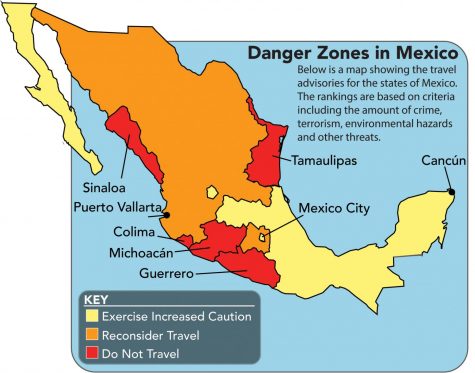Five Mexican states deemed unsafe

The U.S. Department of State issued an updated travel advisory for Mexico on its website on Jan. 10, 2018, giving the Mexican states of Colima, Guerrero, Michoacán, Sinaloa and Tamaulipas a level four rating due to crime, as of Feb. 27, 2018. Travel advisories range from levels one to four, with one being “exercise normal precautions” and four being “do not travel.” They are based on criteria including amount of crime, terrorism, environmental hazards and other threats that could pose a danger to travelers.
Rich Biswell, director of marketing at Journey Mexico, a travel agency that specializes in vacations to Mexico, said in a phone interview that tourists do not often travel to the states with level four warnings since those states only has a few areas for tourism. Popular vacation spots such as Puerto Vallarta, Cancún and the cities’ surrounding areas are mostly safe. Puerto Vallarta is located in Jalisco, which holds a level three rating advising to “reconsider travel,” and Cancún is located in Quintana Roo, which holds a level two rating recommending to “exercise increased caution.” Although the states as a whole may have heightened ratings, resorts and highly populated areas within the states are safer for tourists, as most of the crime the advisories warn against occurs in more remote areas.
“If anything happens to any tourist, it’s a ‘wrong place at the wrong time’ situation,” said Biswell. “Nobody’s going to be targeting them. … What’s the benefit?”
Gary J. Hale, drug policy fellow and Mexico studies scholar at the Baker Institute for Public Policy at Rice University, said in a phone interview that travel warnings are issued around the world for countries in which the United States is represented. For instance, the United States is represented in Mexico through American businesses and tourism. The travel warnings provide a review of the security situation in a country, which may fluctuate at any given time. Colima, Guerrero, Michoacán and Sinaloa are all located on the Pacific coast of Mexico, and Tamaulipas is situated on the U.S.-Mexico border. The Mexican states on the Pacific coast given the highest travel advisory level are dangerous because of gang violence between drug trafficking organizations, also known as cartels. The U.S.-Mexico border is also hazardous because of drugs that come into the United States from Mexico.
“People in those areas have no peace, no tranquility, nothing but fear … all the time because of shootings and bombings and all the stuff that the cartels are doing,” said Hale. “Then you go to another part of the country, and it’s not so bad.”
Junior Samantha Jacobs said she visits her family in the town of Tala, Jalisco, a state in which crime and drug-related issues are prevalent and that is close to the states labeled as “do not travel.” Although members of her family have experienced violence with cartels, she has never witnessed or experienced violence during her time there.
According to junior Caleigh Falk, she has been traveling to Puerto Vallarta during spring break for almost seven years and is planning to go again this spring break. In the last two years, workers at her hotel warned her family against going into the town alone because of potential threats to their safety.
Jacobs said the warnings do not limit her travel to Mexico because she is already aware of the violence that occurs. When she travels to Mexico, she does not go into the main city alone at night, but she and her sister have gone into the city without their parents during the daytime.
According to Hale, travel restrictions change all the time, but he believes the warnings on Mexico are not likely to go away in the near future. He recommends flying from one city to another and taking legitimate taxis to hotels to decrease the risk of being victimized by a cartel.
“It’s kind of like a Russian roulette [where] you don’t know if something is going to happen.
“If you want nothing to happen, don’t go,” said Hale. “If you want to take the chance and just [go to] some beach resort and stay at the hotel and enjoy the beach, you’ll probably be okay.”
Biswell said if tourists decide to travel to Mexico, they should stay around the main tourist areas, be aware of their surroundings and avoid using remote roadways, especially at night.
“I don’t want to make it sound like people have to go to only Cancún or Puerto Vallarta or Cabo,” said Biswell. “You can go to some of the amazing, central cities … that are still … completely safe. It’s just such an amazing, rich, massive, diverse country and there’s so much to do and see.”

